Infantry
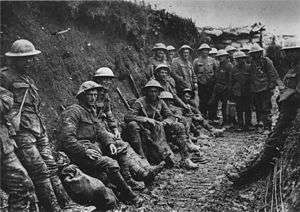
Infantry is the general branch of an army that engages in military combat on foot. As the troops who engage with the enemy in close-ranged combat, infantry units bear the largest brunt of warfare and typically suffer the greatest number of casualties during a military campaign. Historically, as the oldest branch of the combat arms, the infantry are the tip of the spear of a modern army, and continually undergo training that is typically more physically demanding and psychologically stressful than that of any other branch of the combat arms. Common representations of infantry fighting forces include the U.S. Army Infantry Branch, U.S. Marine Corps Infantry, Royal Canadian Infantry Corps, Infantry of the British Army, and the Royal Australian Corps of Infantry.
Infantry can enter and maneuver in terrain that is inaccessible to military vehicles and employ crew-served infantry weapons that provide greater and more sustained firepower. The transport and delivery techniques of modern infantrymen to engage in battle include marching, mechanised transport, aerial drop by parachute or by air assault from helicopter and amphibious landing from the sea.
History and etymology
In English, the 16th-century term Infantry (ca. 1570s) describes soldiers who walk to the battlefield, and there engage, fight, and defeat the enemy in direct combat, usually to take and occupy the terrain. As describing the branch of the combat arms, the term Infantry derives from the French Infanterie, which, in turn, is derived from the Italian Fanteria and ultimately from the Latin Infantera; the individual-soldier term Infantryman (1837) was not coined until the 19th century. Historically, before the invention and the introduction of firearms to warfare, the foot soldiers of previous eras—armed with blunt and edged weapons, and a shield—also are considered and identified as infantrymen.

The term arose in Sixteenth-Century Spain, which boasted one of the first professional standing armies seen in Europe since the days of Rome. It was common to appoint royal princes (Infantes) to military commands, and the men under them became known as Infanteria.
In the Western world, during the Græco–Roman Antiquity (8th–7th centuries BC), and during the Middle Ages (AD 476–1453), infantry soldiers were categorized, characterised, and identified according to the type of weapons and armour with which they were armed, thus heavy infantry (hoplite) and light infantry (Greek peltasts, Roman velites). Since the application of firearms to warfare, the classifications of infantrymen have changed to reflect their formations on the battlefield, such as line infantry, and to reflect the modes of transporting them to the battlefield, and the tactics deployed by specific types of combat units, such as mechanized infantry and airborne infantry.
Combat role
As a branch of the armed forces, the role of the infantry in warfare is to engage, fight, and kill the enemy at close range—using either a firearm (rifle, pistol, machine gun), an edged-weapon (knife, bayonet), or bare hands (close quarters combat)—as required by the mission to hand; thus
.jpg)
- in the Australian Army and New Zealand Army the role of the infantry is "to seek out and close with the enemy, to kill or capture him, to seize and hold ground, to repel attack, by day or night, regardless of season, weather or terrain".[1]
- in the Canadian Army, the role of the infantry is "to close with, and destroy the enemy".[2][3]
- in the U.S. Army, the "infantry closes with the enemy, by means of fire and maneuver, in order to destroy or capture him, or to repel his assault by fire, close combat, and counterattack".[4]
- in the U.S. Marine Corps, the role of the infantry is to "locate, close with, and destroy the enemy with fire and maneuver, and to repel the enemy assault by fire and close combat".[5]
Beginning with the Napoleonic Wars of the early 19th century, artillery has become an increasingly dominant force on the battlefield. Since World War I, combat aircraft and armoured vehicles have also become dominant. However, the most effective method for locating all enemy forces on a battlefield is still the infantry patrol, and it is the presence or absence of infantry that ultimately determines whether a particular piece of ground has been captured or held. In 20th and 21st century warfare, infantry functions most effectively as part of a combined arms team including artillery, armour, and combat aircraft. Studies have shown that of all casualties, 50% or more were caused by artillery; about 10% were caused by machine guns; 2–5% by rifle fire; and 1% or less by hand grenades, bayonets, knives, and unarmed combat combined. Several infantry divisions both Allied and Axis in the European theatre of WWII suffered higher than 100% combat and non combat casualties and some above 200%, meaning that the number of service personnel that became casualties was greater than the sum of the divisions' available service positions at full strength.
Organization

Infantry relies on organized formations to be employed in battle. These have evolved over time, but remain a key element to effective infantry development and deployment. Until the end of the 19th century, infantry units were for the most part employed in close formations up until contact with the enemy. This allowed commanders to retain control of the unit, especially while maneuvering, as well as allowing officers to retain discipline amongst the ranks.
The development of machine guns and other weapons with increased firepower forced infantry units to disperse in order to make them less vulnerable to such weapons. This decentralization of command was made possible by improved communications equipment and greater focus on small unit training. From World War I, it was recognized that infantry were best employed when using their ability to maneuver in constricted terrain, and evade detection in ways not possible for other weapons such as vehicles.
Among the various subtypes of infantry is "Medium infantry." This refers to infantry which are less heavily armed and armored than heavy infantry, but more so than light infantry. In the early modern period, medium infantry were largely eliminated due to discontinued use of body armour up until the 20th century. In the United States Army, Stryker Infantry is considered Medium Infantry, since they are "heavier" than light infantry but "lighter" than mechanized infantry.
Doctrine
Infantry doctrine is the concise expression of how infantry forces contribute to campaigns, major operations, battles, and engagements. It is a guide to action, not a set of hard and fast rules.
Doctrine provides a very common frame of reference across the military forces, allowing the infantry to function cooperatively in what are now called combined arms operations. Doctrine helps standardise operations, facilitating readiness by establishing common ways of accomplishing infantry tasks. Doctrine links theory, history, experimentation, and practice. Its objective is to foster initiative and creative thinking in the infantry's tactical combat environment.
Doctrine provides the infantry with an authoritative body of statements on how infantry forces conduct operations and provides a common lexicon for use by infantry planners and leaders.
Until the development of effective artillery doctrines, and more recently precision guided air delivered ordnance, the most recent important role of the infantry has been as the primary force of inflicting casualties on the enemy through aimed fire. The infantry is also the only combat arm which can ultimately decide whether any given tactical position is occupied, and it is the presence of infantry that assures control of terrain. While the tactics of employment in battle have changed, the basic missions of the infantry have not.
Retractions to the infantry concept
Although it has been argued that infantrymen and infantry tactics are an antiquated and careless use of military manpower and resources, the infantryman has proven quite capable against many units, some much more sophisticated. For instance, light infantry has proven to be effective against tank units by exploiting a tank's limited field of fire and view when using grenades or antitank rockets. Air bombardment that otherwise have flattened cities may be ineffective against a dug in infantry force, such as at the Battle of Stalingrad 1942–1943.
Operations
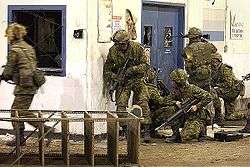
Attack operations
Attack operations are the most basic role of the infantry, and along with defense, form the main stances of the infantry on the battlefield. Traditionally, in an open battle, or meeting engagement, two armies would maneuver to contact, at which point they would form up their infantry and other units opposite each other. Then one or both would advance and attempt to defeat the enemy force. The goal of an attack remains the same: to advance into an enemy-held objective, most frequently a hill, river crossing, city or other dominant terrain feature, and dislodge the enemy, thereby establishing control of the objective.
Attacks are often feared by the infantry conducting them because of the high number of casualties suffered while advancing to close with and destroy the enemy while under enemy fire. In mechanized infantry the armored personnel carrier (APC) is considered the assaulting position. These APCs can deliver infantrymen through the front lines to the battle and—in the case of infantry fighting vehicles—contribute supporting firepower to engage the enemy. Successful attacks rely on sufficient force, preparative reconnaissance and battlefield preparation with bomb assets. Retention of discipline and cohesion throughout the attack is paramount to success. A subcategory of attacks is the ambush, where infantrymen lie in wait for enemy forces before attacking at a vulnerable moment. This gives the ambushing infantrymen the combat advantage of surprise, concealment and superior firing positions, and causes confusion. The ambushed unit does not know what it is up against, or where they are attacking from.
Patrol operations
Patrolling is the most common infantry mission. Full-scale attacks and defensive efforts are occasional, but patrols are constant. Patrols consist of small groups of infantry moving about in areas of possible enemy activity to locate the enemy and destroy them when found. Patrols are used not only on the front-lines, but in rear areas where enemy infiltration or insurgencies are possible.
Pursuit operations
Pursuit is a role that the infantry often assumes. The objective of pursuit operations is the destruction of withdrawing enemy forces which are not capable of effectively engaging friendly units, before they can build their strength to the point where they are effective. Infantry traditionally have been the main force to overrun these units in the past, and in modern combat are used to pursue enemy forces in constricted terrain (urban areas in particular), where faster forces, such as armoured vehicles are incapable of going or would be exposed to ambush.
Defense operations
Defense operations are the natural counter to attacks, in which the mission is to hold an objective and defeat enemy forces attempting to dislodge the defender. Defensive posture offers many advantages to the infantry, including the ability to use terrain and constructed fortifications to advantage; these reduce exposure to enemy fire compared with advancing forces. Effective defense relies on minimizing losses to enemy fire, breaking the enemy's cohesion before their advance is completed, and preventing enemy penetration of defensive positions.
Escort operations
Escorting consists of protecting support units from ambush, particularly from hostile infantry forces. Combat support units (a majority of the military) are not as well armed or trained as infantry units and have a different mission. Therefore, they need the protection of the infantry, particularly when on the move. This is one of the most important roles for the modern infantry, particularly when operating alongside armored vehicles. In this capacity, infantry essentially conducts patrol on the move, scouring terrain which may hide enemy infantry waiting to ambush friendly vehicles, and identifying enemy strong points for attack by the heavier units.
Base defense
Infantry units are tasked to protect certain areas like command posts or airbases. Units assigned to this job usually have a large number of military police attached to them for control of checkpoints and prisons.
Maneuvering operations
Maneouvering consumes much of an infantry unit's time. Infantry, like all combat arms units, are often maneuvered to meet battlefield needs, and often must do so under enemy attack. The infantry must maintain their cohesion and readiness during the move to ensure their usefulness when they reach their objective. Traditionally, infantry have relied on their own legs for mobility, but mechanised or armoured infantry often uses trucks and armored vehicles for transport. These units can quickly disembark and transition to light infantry, without vehicles, to access terrain which armoured vehicles can't effectively access.
Reconnaissance/intelligence gathering
Surveillance operations are often carried out with the employment of small recon units or sniper teams which gather information about the enemy, reporting on characteristics such as size, activity, location, unit and equipment. These infantry units typically are known for their stealth and ability to operate for periods of time within close proximity of the enemy without being detected. They may engage high-profile targets, or be employed to hunt down terrorist cells and insurgents within a given area. These units may also entice the enemy to engage a located recon unit, thus disclosing their location to be destroyed by more powerful friendly forces.
Military reserve force
Some assignments for infantry units involve deployment behind the front, although patrol and security operations are usually maintained in case of enemy infiltration. This is usually the best time for infantry units to integrate replacements into units and to maintain equipment. Additionally, soldiers can be rested and general readiness should improve. However, the unit must be ready for deployment at any point.
Construction/engineering
This can be undertaken either in reserve or on the front, but consists of using infantry troops as labor for construction of field positions, roads, bridges, airfields, and all other manner of structures. The infantry is often given this assignment because of the physical quantity of strong men within the unit, although it can lessen a unit's morale and limit the unit's ability to maintain readiness and perform other missions. More often, such jobs are given to specialist engineering corps.
Raids/Hostage rescue
Infantry units are trained to quickly mobilise, infiltrate, enter and neutralize threat forces when appropriate combat intelligence indicates to secure a location, rescue or capture high-profile targets.
Urban combat
Urban combat poses unique challenges to the combat forces. It is one of the most complicated type of operations an infantry unit will undertake. With many places for the enemy to hide and ambush from, infantry units must be trained in how to enter a city, and systematically clear the buildings, which most likely will be booby trapped, in order to kill or capture enemy personnel within the city. Care must be taken to differentiate innocent civilians who often hide and support the enemy from the non-uniformed armed enemy forces. Civilian and military casualties both are usually very high.[6]
Day to day service

Because of an infantryman's duties with firearms, explosives, physical and emotional stress, and physical violence, casualties and deaths are not uncommon in both war and in peacetime training or operations. It is a highly dangerous and demanding combat service; in World War II, military doctors concluded that even physically unwounded soldiers were psychologically worn out after about 200 days of combat.
The physical, mental, and environmental operating demands of the infantryman are high. All of the combat necessities such as ammunition, weapon systems, food, water, clothing, and shelter are carried on the backs of the infantrymen, at least in light role as opposed to mounted/mechanised. Combat loads of over 36 kg (80 lbs) are standard, and greater loads in excess of 45 kg (100 lbs) are very common.[7][8] These heavy loads, combined with long foot patrols of over 40 km (25 mi) a day, in any climate from 43 to −29 °C (109 to −20 °F) in temperature, require the infantryman to be in good physical and mental condition. Infantrymen live, fight and die outdoors in all types of brutal climates, often with no physical shelter. Poor climate conditions adds misery to this already demanding existence. Disease epidemics, frostbite, heat stroke, trench foot, insect and wild animal bites are common along with stress disorders and these have sometimes caused more casualties than enemy action.[9]
Despite the hardships, infantrymen are expected to continue with their combat missions despite death and injury of friends, fear, despair, fatigue, and bodily injury.

Some infantry units are considered Special Forces. The earliest Special Forces commando units were more highly trained infantrymen, with special weapons, equipment, and missions. Special Forces units recruit heavily from regular infantry units to fill their ranks.
Foreign and domestic militaries typically have a slang term for their infantrymen. In the U.S. military, the slang term among both Marine and Army infantrymen for themselves is "grunt." In the British Army, they are the "squaddies." The infantry is a small close-knit community, and the slang names are terms of endearment that convey mutual respect and shared experiences.
Equipment and training
The Training of the infantry has differed drastically over time and from place to place. The antiquity saw everything from the well-trained citizen armies of Greek and Rome, the tribal host assembled from farmers and hunters with only passing acquaintance with warfare and masses of lightly armed and ill-trained militia put up as a last ditch effort. In medieval times the foot soldier ran the gamut from peasant levies to semi-permamanent mercenary host of mercenaries, foremost among them the Swiss, English, Aragonese and German companies, to the men-at-arms who went into battle as well-armored as knights who at times also fought on foot. The modern age saw an increase in training standards, mostly due to the increased use of firearms and the need for drill to handle them efficiently. The introduction of national and mass armies saw an establishment of minimum requirements and the introduction of special troops (first of them the engineers going back to medieval times, but also different kinds of infantry adopted to specific terrain, bicycle, motorcycle, motorized and mechanized troops) culminating with the introduction of highly-trained special forces during the first and second World War.
The equipment of infantry forces has evolved along with the development of military technology and tactics in general, but certain constants remain regarding the design and selection of this equipment. Primary types of equipment are weaponry, protective gear, survival gear, and special, mission specific equipment. Infantry tactics have become much more involved, and yet must be learned and rehearsed until they become second nature when the infantry soldier is stumbling with fatigue and in the middle of the "fog of war." Spreading out, making use of cover and concealment, monitoring team-mates and leaders, and watching for the enemy must all become instinctive and simultaneous.

Infantry weapons have included all types of personal weapons, i.e., anything that can be handled by individual soldiers, as well as some light crew-served weapons that can be carried. During operations, especially in modern times, the infantry often scavenge and employ whatever weapons and equipment they can acquire from both friend and foe, in addition to those issued to them by their available supply chain.
Infantry of ancient times through the Renaissance wielded a wide array of non-gunpowder weaponry. Infantry formations used all sorts of melee weapons, such as various types of swords, axes, and maces; shock weapons, such as spears and pikes; and ranged weapons such as javelins, bows, and slings. Their crew-served weapons were the ballista and the battering ram. Infantry of these premodern periods also wore a variety of personal body armour, including chain mail and cuirasses. Many of the premodern infantry weapons evolved over time to counter these advances in body armor, such as the falchion and crossbow, which were designed to pierce chain mail armor and wound the underlying body.
Modern infantrymen may be trained to use equipment in addition to their personal rifles, such as hand guns or pistols, shotguns, machine guns, anti-tank missiles, infantry mortars, anti-personnel mines, other incendiary and explosive devices, bayonets, GPS, map and compass, encrypted communications equipment, booby traps, surveillance equipment, night vision equipment, sensitive intelligence documents, classified weapon systems and other sensitive equipment.
Protective equipment and survival gear
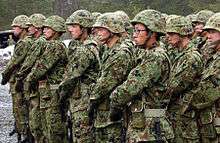
Infantry protective gear includes all equipment designed to protect the soldier against enemy attack. Most protective gear comprises personal armor of some type. Ancient and medieval infantry used shields and wore leather and metal alloys for armour, as defense against both missile and hand-to-hand weapons. With the advent of effective firearms such as the arquebus, large numbers of men could be quickly trained into effective fighting forces, and such armour became thicker while providing less overall coverage to meet the threat of early firearms, which could only pierce this armour at close range. Generally, only pikemen were armoured in this fashion; gunners went largely unarmoured, due to the expense as well as the impracticality of armouring large numbers of men who were not expected to fight in close quarters where it would be most useful. As firearms became more powerful and armour became less useful against gunfire, the ratio of gunners to pikemen increased, until the advent of the bayonet rendered the latter entirely obsolete. While it became clear to most military leaders that the pikeman was now outdated, some armies stubbornly clung to the pike, though pikemen, too, would abandon their armour, until only specialized and prestigious cavalry units retained any significant armour coverage; the infantryman from this point went entirely unarmoured. The return to the use of the helmet was prompted by the need to defend against high explosive fragmentation and concussion, and further developments in materials led to effective bullet-defeating body armour such as Kevlar, within the weight acceptable for infantry use.
Beginning in the Vietnam War, the use of personal body armour has again become widespread among infantry units. Infantrymen must also often carry protective measures against chemical and biological attack, including gas masks, counter-agents, and protective suits. All of these protective measures add to the weight an infantryman must carry, and may decrease combat efficiency. Modern militaries are struggling to balance the value of personal body protection versus the weight burden and ability to move under such weight.
Infantry survival gear includes all of the items soldiers require for day-to-day survival in the combat environment. These include basic environmental protections, medical supplies, food, and sundries. As the amount of equipment a soldier can carry is very limited, efforts have been made to make equipment light and compact. Equipment is carried in tactical gear (such as ALICE), which should be comfortable to wear for extended periods of time, hamper movement as little as possible and be compatible with other things a soldier can be expected to carry, such as field radios and spare ammunition. Infantry have suffered high casualty rates from disease, exposure, and privation—often in excess of the casualties suffered from enemy attacks. Better equipment of troops to protect against these environmental factors greatly reduces these rates of loss. One of the most valuable pieces of gear is the entrenching tool—basically a folding spade—which can be employed not only to dig important defenses, but also in a variety of other daily tasks and even as a weapon.
Specialized equipment consists of a variety of gear which may or may not be carried, depending on the mission and the level of equipment of an army. Communications gear has become a necessity, as it allows effective command of infantry units over greater distances, and communication with artillery and other support units. In some units, individual communications are being used to allow the greatest level of flexibility. Engineering equipment, including explosives, mines, and other gear, is also commonly carried by the infantry or attached specialists. A variety of other gear, often relating to a specific mission, or to the particular terrain in which the unit is employed, can be carried by infantry units.
Other infantry
Naval infantry, commonly known as marines, are primarily a category of infantry that form part of the naval forces of states and perform roles on land and at sea, including amphibious operations, as well as other, naval roles. They also perform other tasks, including land warfare, separate from naval operations.
Base defence forces and infantry units in air forces, such as the Royal Air Force Regiment, Royal Australian Air Force Airfield Defence Guards, and United States Air Force Security Forces, are used primarily for ground-based defence of air bases and other, air force facilities. They also have a number of other, specialist roles. These include, among others, Chemical, Biological, Radiological and Nuclear (CBRN) defence and training other, air force personnel in basic ground defence tactics.
Descriptions of infantry
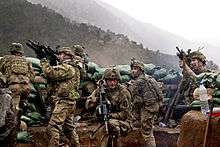
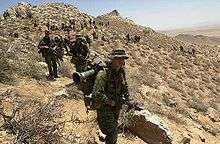
- "Ah, yes, mere infantry—poor beggars. ..." —Plautus[10]
- "Let us be clear about three facts: First, all battles and all wars are won, in the end, by the infantryman. Secondly, the infantryman always bears the brunt; his casualties are heavier, he suffers greater extremes of discomfort and fatigue than the other [combat] arms. Thirdly, the art of the infantryman is less stereotyped, and far harder to acquire in modern war, than that of any other arm." — Field Marshal Earl Wavell[11]
- "I love the infantry, because they are the underdogs. They are the mud-rain-frost-and-wind boys. They have no comforts, and they even learn to live without the necessities; and, in the end, they are the guys that wars can't be won without." —Ernie Pyle[12]
- "I’m convinced that the infantry is the group in the army which gives more, and gets less, than anybody else." —Up Front (1945), by Bill Mauldin[13]
- "Never think that war, no matter how necessary, nor how justified, is not a crime. Ask the infantry, and ask the dead." —Ernest Hemingway[14]
- "One might as well try to charge through a wall". —Napoleon - On St Helena (regarding the British Infantry)
- "The infantry doesn't change. We're the only arm [of the army] where the weapon is the man, himself." —C.T. Shortis[15]
- "The army's infantry is its most essential component. Even today, no army can take and hold any ground without the use of infantry." —George Nafziger[16]
- "There is no beating these [British and Spanish] troops, in spite of their generals. I always thought they were bad soldiers, now I am sure of it. I had turned their right, pierced their centre, and, everywhere, victory was mine — but they did not know how to run!" —Field Marshal Jean de Dieu Soult, Battle of Albuera (16 May 1811), the Peninsular War (1808–14).
- "Americans in 1950 rediscovered something that since Hiroshima they had forgotten: you may fly over a land forever; you may bomb it, atomize it, pulverize it and wipe it clean of life – but if you desire to defend it, protect it, and keep it for civilization, you must do this on the ground, the way the Roman legions did, by putting your young men into the mud." —Military historian T.R. Fehrenbach
See also
- Air Assault infantry
- Air Force infantry
- Airborne infantry
- Armoured (Armored) infantry
- British infantry
- Foot Guards
- Fusiliers
- Grenadiers
- Heavy infantry
- Infantry Branch (United States)
- Infantry tactics
- Light infantry
- Line Infantry
- List of National Infantry Training Schools
- Marine infantry
- Mechanized Infantry
- Medium infantry
- Motorized infantry
- Mounted infantry
- Naval infantry
- Ranger infantry
- Riflemen
- Royal Canadian Infantry Corps
- Special Operations Forces
- U.S. Marine Corps infantry
Citations and notes
- ↑ Royal Australian Corps of Infantry at www.army.gov.au
- ↑ Canadian Forces Publication B-GL-392-001/FP-001 The Infantry Battalion in Battle, Volume 1
- ↑ Canadian Forces Publication B-GL-301-002/FP-001 The battle Group in Operations, Change 2, 1992-02-03.
- ↑ FM7-8, Infantry Rifle Platoon and Squad
- ↑ MOS 0311
- ↑ The United States Army's Preparedness to Conduct Urban Combat: A Strategic Priority, pp. 2–3
- ↑ "Infantry: The Weight Won't Go Away". strategypage.com. Retrieved 27 December 2015.
- ↑ "U.S. Army Medical Department Center & School Portal" (PDF). army.mil. Retrieved 27 December 2015.
- ↑ "U.S. Army Medical Department Center & School Portal" (PDF). army.mil. Retrieved 27 December 2015.
- ↑ p. 156, Heinl
- ↑ In Praise of Infantry, by Field Marshal Archibald Wavell, 1st Earl Wavell, The Times, Thursday, 19 April 1945
- ↑ p. 257, Tobin
- ↑ p. 5, Mauldin & Ambrose
- ↑ p. 262, Trogdon
- ↑ The New York Times, Shortis
- ↑ p. 13, Nafziger
References
- English, John A., Gudmundsson, Bruce I., On Infantry, (Revised edition), The Military Profession series, Praeger Publishers, London, 1994 ISBN 0-275-94972-9
- The Times, Earl Wavell, Thursday, 19 April 1945 In Praise of Infantry
- Tobin, James, Ernie Pyle's War: America's Eyewitness to World War II, Free Press, 1997
- Mauldin, Bill, Ambrose, Stephen E., Up Front, W. W. Norton, 2000
- Trogdon, Robert W., Ernest Hemingway: A Literary Reference, Da Capo Press, 2002
- The New York Times, Maj Gen C T Shortis, British Director of Infantry, 4 February 1985
- Heinl, Robert Debs, Dictionary of Military and Naval Quotations, Plautus in The Braggart Captain (3rd century CE), Naval Institute Press, Annapolis, 1978
- Nafziger, George, Napoleon's Invasion of Russia, Presidio Press, 1998
- McManus, John C. Grunts: inside the American infantry combat experience, World War II through Iraq New York, NY: NAL Caliber. 2010 ISBN 978-0-451-22790-4 plus Webcast Author Lecture at the Pritzker Military Library on September 29, 2010
External links
| Wikimedia Commons has media related to Infantry. |
- Historic films and photos showing Infantries in World War I at europeanfilmgateway.eu
- In Praise of Infantry, by Field-Marshal Earl Wavell; First published in "The Times," Thursday, 19 April 1945.
- The Lagunari "Serenissima" Regiment KFOR: KFOR Chronicle.
- Web Version of U.S. Army Field Manual 3-21.8 – The Infantry Rifle Platoon and Squad.
